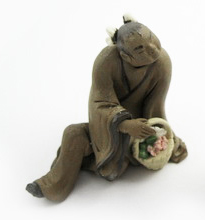
A few days ago, I showed a set of bonsai figurines of the Eight Immortals to a friend from UK. I didn’t expect him to know anything about the Eight Immortals, and I was about to tell him more of this Chinese folklore. Yet, to my surprise, what my British friend knows of this group of legendary fairies is quite a bit, if not more than I do! (My friend later told me that he did a Wikipedia search after he bought a scroll of the Eight Immortals in Shanghai.)
So, the Eight Immortals are characters found in Chinese folklore. They were actually mortal beings until they performed kind deeds, or got into some miraculous accidents. These Eight Immortals represent all kinds of people – rich, poor, young, old, man, woman, military, cultured, noble. Because they are not gods, they can only visit, but not live in Heaven. These Eight Immortals enjoy traveling. They love to get together and roam around, often causing both laughter and troubles. They fight dragons, steal from Gods, enjoy parties and a good drink.
Below is a brief description of each of the Eight Immortals.
Zhang Guo Lao (張果老)
Zhang Guo Lao is represented as an old man riding a white mule with a tube-shaped musical instrument made of bamboo in his hands. This white mule could get Zhang to incredible distances, and be folded into Zhang’s wallet at the end of each journey. Whenever Zhang wanted to travel again, he would sprinkle water on his wallet and the white mule would reappear.

Zhong Li Quan (鐘离權)
Zhong Li Quan is the Chief of the 8 Immortals. He is the fat guy with his bare belly showing. Zhong always carries a fan and sometimes a peach.
Cao Gou Jiu (曹國舅)
Cao Gou Jiu was the brother of the Emperor of the Song Dynasty and the son of a military commander. He is the finest dressed among the eight immortals. He is always shown wearing formal court dress and carrying castinets.

Li Tie Guai (李鐵拐)
Li Tie Guai is depicted as a beggar with a crutch and a gourd. The legend has it that Li had the magical skill of freeing his soul from his body. One day while Li’s spirit was gone from his body, his body was found and mistakenly thought as dead. It was then burned, as was traditional. When Li returned from his travels, he found that he had lost his body and was forced to enter the body of a lame beggar.
Lu Dong Bin (呂洞賓)
Lu Dong Bin was an 8th-century scholar. Upon his back he wears a magic sword that used to slay dragons and demons. In his hand he carries a fly brush.

Lan Cai He (蓝采和)
Lan Cai He is variously portrayed as a youth, sometimes as a boy, other times as a girl. He/She is the strolling singer who often shown wearing blue robe and carrying a basket of flowers.
He Xian Gu (何仙姑)
One day when He Xian Gu was in the mountain collecting herbs, she met Lu Dong Bin who gave her a magic peach. After He ate the peach, she became immortal with the ability to see the future. He is often seen carrying a magical lotus blossom and a fly-whisk.

Han Xiang Zi (韓湘子)
Han Ziang Zi is the Happy Man. He is said to be the nephew of Han Yu, a famous scholar in Tang Dynasty. Han is always seen playing a flute. It is said that Han could make flowers bloom with his will and soothe wild animals with his music.






























